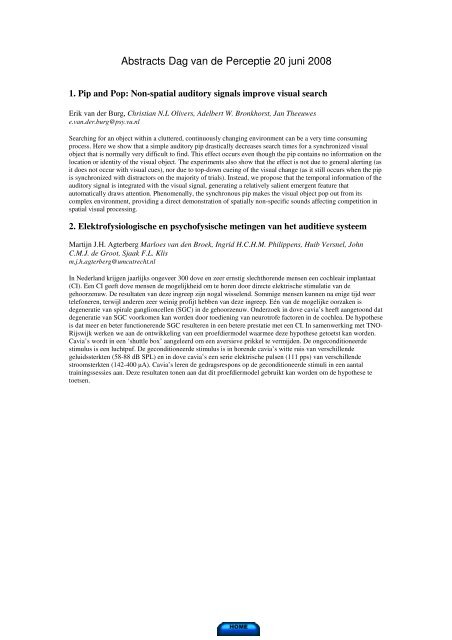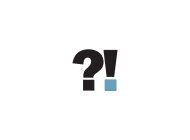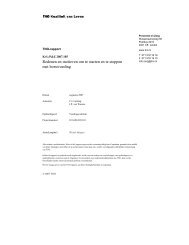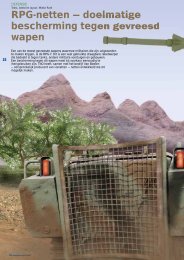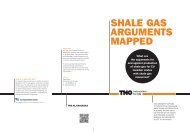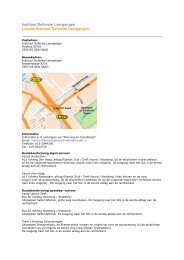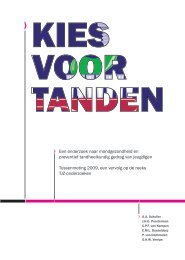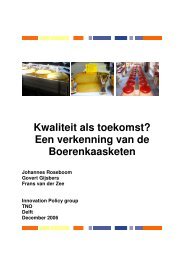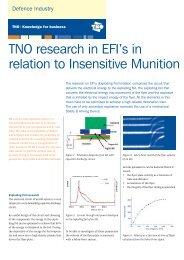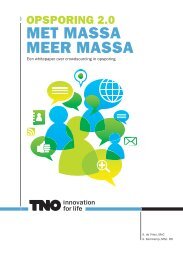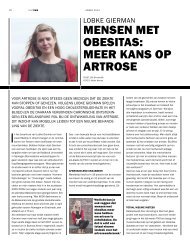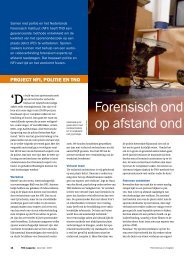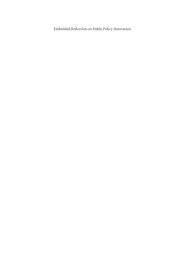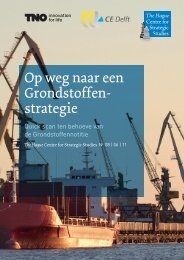Dag van de Perceptie - TNO
Dag van de Perceptie - TNO
Dag van de Perceptie - TNO
Create successful ePaper yourself
Turn your PDF publications into a flip-book with our unique Google optimized e-Paper software.
Abstracts <strong>Dag</strong> <strong>van</strong> <strong>de</strong> <strong>Perceptie</strong> 20 juni 2008<br />
1. Pip and Pop: Non-spatial auditory signals improve visual search<br />
Erik <strong>van</strong> <strong>de</strong>r Burg, Christian N.L Olivers, A<strong>de</strong>lbert W. Bronkhorst, Jan Theeuwes<br />
e.<strong>van</strong>.<strong>de</strong>r.burg@psy.vu.nl<br />
Searching for an object within a cluttered, continuously changing environment can be a very time consuming<br />
process. Here we show that a simple auditory pip drastically <strong>de</strong>creases search times for a synchronized visual<br />
object that is normally very difficult to find. This effect occurs even though the pip contains no information on the<br />
location or i<strong>de</strong>ntity of the visual object. The experiments also show that the effect is not due to general alerting (as<br />
it does not occur with visual cues), nor due to top-down cueing of the visual change (as it still occurs when the pip<br />
is synchronized with distractors on the majority of trials). Instead, we propose that the temporal information of the<br />
auditory signal is integrated with the visual signal, generating a relatively salient emergent feature that<br />
automatically draws attention. Phenomenally, the synchronous pip makes the visual object pop out from its<br />
complex environment, providing a direct <strong>de</strong>monstration of spatially non-specific sounds affecting competition in<br />
spatial visual processing.<br />
2. Elektrofysiologische en psychofysische metingen <strong>van</strong> het auditieve systeem<br />
Martijn J.H. Agterberg Marloes <strong>van</strong> <strong>de</strong>n Broek, Ingrid H.C.H.M. Philippens, Huib Versnel, John<br />
C.M.J. <strong>de</strong> Groot, Sjaak F.L. Klis<br />
m.j.h.agterberg@umcutrecht.nl<br />
In Ne<strong>de</strong>rland krijgen jaarlijks ongeveer 300 dove en zeer ernstig slechthoren<strong>de</strong> mensen een cochleair implantaat<br />
(CI). Een CI geeft dove mensen <strong>de</strong> mogelijkheid om te horen door directe elektrische stimulatie <strong>van</strong> <strong>de</strong><br />
gehoorzenuw. De resultaten <strong>van</strong> <strong>de</strong>ze ingreep zijn nogal wisselend. Sommige mensen kunnen na enige tijd weer<br />
telefoneren, terwijl an<strong>de</strong>ren zeer weinig profijt hebben <strong>van</strong> <strong>de</strong>ze ingreep. Eén <strong>van</strong> <strong>de</strong> mogelijke oorzaken is<br />
<strong>de</strong>generatie <strong>van</strong> spirale ganglioncellen (SGC) in <strong>de</strong> gehoorzenuw. On<strong>de</strong>rzoek in dove cavia’s heeft aangetoond dat<br />
<strong>de</strong>generatie <strong>van</strong> SGC voorkomen kan wor<strong>de</strong>n door toediening <strong>van</strong> neurotrofe factoren in <strong>de</strong> cochlea. De hypothese<br />
is dat meer en beter functioneren<strong>de</strong> SGC resulteren in een betere prestatie met een CI. In samenwerking met <strong>TNO</strong>-<br />
Rijswijk werken we aan <strong>de</strong> ontwikkeling <strong>van</strong> een proefdiermo<strong>de</strong>l waarmee <strong>de</strong>ze hypothese getoetst kan wor<strong>de</strong>n.<br />
Cavia’s wordt in een ‘shuttle box’ aangeleerd om een aversieve prikkel te vermij<strong>de</strong>n. De ongeconditioneer<strong>de</strong><br />
stimulus is een luchtpuf. De geconditioneer<strong>de</strong> stimulus is in horen<strong>de</strong> cavia’s witte ruis <strong>van</strong> verschillen<strong>de</strong><br />
geluidssterkten (58-88 dB SPL) en in dove cavia’s een serie elektrische pulsen (111 pps) <strong>van</strong> verschillen<strong>de</strong><br />
stroomsterkten (142-400 µA). Cavia’s leren <strong>de</strong> gedragsrespons op <strong>de</strong> geconditioneer<strong>de</strong> stimuli in een aantal<br />
trainingssessies aan. Deze resultaten tonen aan dat dit proefdiermo<strong>de</strong>l gebruikt kan wor<strong>de</strong>n om <strong>de</strong> hypothese te<br />
toetsen.


